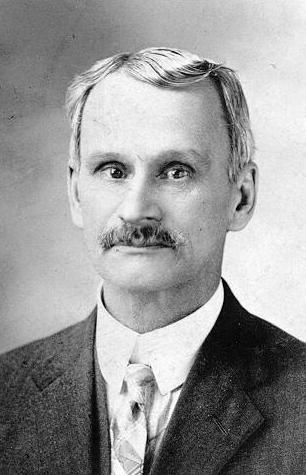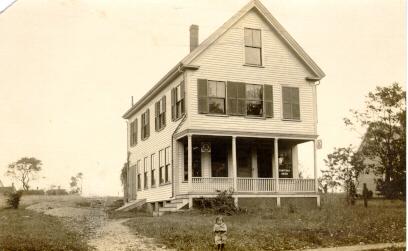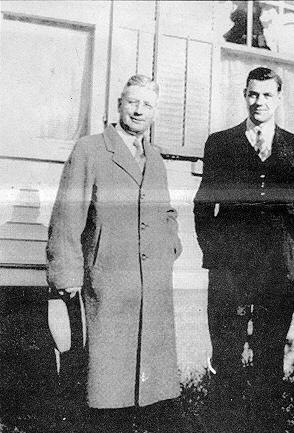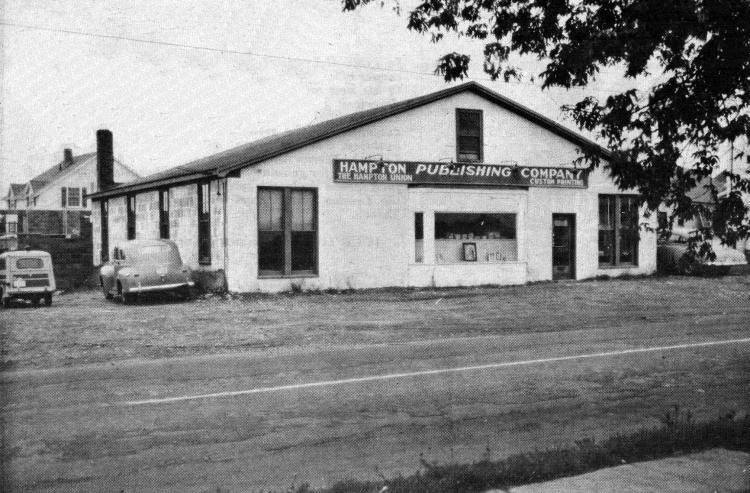Celebrating A Century of Service Since 1899
Hampton Union
September 28, 1999
75th Anniversary edition of Hampton Union, July 23, 1975,
compiled by John M. Holman, Doris Bragg and Melody Dahl.]
On June 14, 1899, the presses rolled and the first issue of The Hamptons Union hit the streets along Seacoast towns. It was the first edition of what would become a mainstay in the communities it serves.
 Charles Francis Adams, 1866-1950
Charles Francis Adams, 1866-1950
And the paper has been published continuously since, a feat founder Charles Francis Adams might not have envisioned when he hollered "roll the presses" a century ago.
On June 14,1999, Hampton Union celebrated its 100th year of publication.
Adams, born July 10, 1866, in Sherborn, Mass., was the son of Alden and Charlotte (Fales) Adams. Before coming to Hampton, he served on the Massachusetts Gypsy Moth Commission from 1897 to 1899. During his tenure at the newspaper, he would represent Hampton in the New Hampshire General Court, was a special justice of the Hampton Municipal Court, deputy town clerk and town auditor. He died May 22, 1950, at age 83.
The first issue of The Hamptons Union was scheduled to be published earlier than June, however machinery needed for its publication failed to arrive in town on time. Page 1 of Vol. 1, No. 1, produced on a flatbed press, was covered solely with advertisements, including those from Batchelder’s at Little Boar’s Head, the Hotel Whittier (D.H. Whittier proprietor) and Jenkins’ Cafe on Hampton Beach. The first issue included 47 advertisements and a few news items inside, including "Two special cars (trolley) brought the Daughters of New Hampshire from Exeter to Hampton Beach" and "The entrance examinations of Hampton Academy will be held at the academy building on Monday, June 19, beginning at 9 a.m."
Subscriptions to the paper were available for $1 per year and 50 cents for six months.
Individual copies sold for 3 cents (later in the century single issues would cost 1 cent, before jumping to 20 cents in the 1970s, to 50 cents in the early 1990s and to 75 cents today).
In the first few years of its publication, circulation quickly soared to more than 150 copies. Adams published the newspaper for more than 30 years before selling out.
In the early 1920s, Adams improved production of the paper by adding a Linotype machine. During Adams’ tenure, the printing company also printed town reports, said Adams’ daughter, Constance Adams Billings in a 1975 interview, on the occasion of the newspaper’s 75th anniversary. Edward S. Seavey, a Greenland native and longtime summer visitor to the beach, owned a large printing business in Haverhill, Mass. He purchased the newspaper and moved his printing business to Hampton. naming it the Hampton Publishing Company. Seavey published the Union as a sideline to the printing operation, according to Carl Bragg, who worked at the paper in the late 1940s through early 1960s with Seavey’s son, Edward Jr.
 The Hampton Union Building at 92 High St. with a young Constance (Adams) Billings in front
The Hampton Union Building at 92 High St. with a young Constance (Adams) Billings in front
According to Carl Bragg and his wife Doris, The Hamptons Union, as it was called at the time, was first published in the Shaw Building in Hampton [south corner of High Street and Lafayette Road]. At one point the paper was published at 92 High Street, until 1929 when Seavey bought a former general store at the corner of Lafayette Road and Exeter Road [then called "The Goody Cole Room", now in 1999, the office of the Hampton Beach Area Chamber of Commerce.]
Seavey published the first edition of the paper, now named Hampton Union, from that building on January 9, 1930. After the building was sold to Albert Lamie in 1932, Seavey constructed a new shop at 20 Mill Road, on land behind his family residence at the corner of Winnacunnet and Mill roads.
 Edward S. Seavey Sr. & Edward S. Seavey, Jr.
Edward S. Seavey Sr. & Edward S. Seavey, Jr.
The Seaveys had three children, Edward, Ruth and Doris, and while they attended high school they worked in the production department of the printing business. Seavey started the Hampton Beach Advocate (later named The Beachcomber), which was distributed in the summer. When the elder Seavey retired in 1938, he sold the business to his son,. Edward Jr. The younger Seavey purchased Hackett’s Garage at 575 Lafayette Road and moved the printing business and newspaper offices there.

The sixth home of the Union, located at 575 Lafayette Road. This was the home of the Union between 1939-1968.
Doris Seavey, meanwhile, married Carl Bragg in 1936, and in 1945, Bragg purchased a one-quarter interest in the newspaper. The partnership would last 18 years. During the late 1940s and 1950s, two additions were constructed at the Lafayette Road site to accommodate new newspaper presses.
The partnership between Seavey and Bragg ended when Seavey died on June 16, 1963, of a heart attack while vacationing at his summer cottage in Barrington.
The Seavey heirs and Bragg sold the business to Wesley Powell of Hampton Falls in the fall of 1963. Powell’s ownership of Hampton Union lasted for only five years. Bragg said recently that Powell used the newspaper to further his political career. Powell certainly used Hampton Union to publicize his views, often writing hard-hitting editorials concerning his political rivals.
In 1968, Powell sold the newspaper to Norman E. Bailey, a well-known Manchester radio announcer and publisher of The Big Town Shopper. For a short time Bailey moved the newspaper operation to the Woodbury building in Depot Square, in downtown Hampton.
A year later he moved the paper to the second floor of a house he had purchased on Lafayette Road in Seabrook. Bailey lived on the first floor.
Bailey, operating under the name Bailey Publications, concentrated on publication of Hampton Union; a newly created Smart—Shopper, circulating in the Newburyport, Mass, area; an expanded version of the Rockingham County Gazette; and The Beachcomber.
Under Bailey, the paper was printed in Rochester, but in 1970 he arranged to have the Union printed in Boston. Circulation Manager Barry McComb recalled the move. "It was a total disaster. We had late papers like you wouldn’t believe," he recalled this month.
In December 1971, Bailey sold the publishing house to Dear Publication and Radio Inc., a Washington D.C. based publishing company. Ralph C. Dear, one of the members of the Dear family, was brought in as general manager of the company.
In 1975, Hampton Union and its sister publications were bought by Essex County Newspapers of Gloucester, Mass. Under Philip S. Weld, president, and Alexander N. Stoddart, publisher, Hampton Union moved back to Hampton, relocating to 58 Winnacunnet Road.
Stoddart and Weld had started newspapers in Gloucester and Newburyport in the early 1950s. Stoddart had been named publisher in 196O, when Weld took a leave of absence to serve as publisher of The Paris "Trib."
ECN moved Hampton Union office back to Winnacunnet Road in Hampton and the Union was printed in Beverly, Mass. from 1975 to 1982.
Weld and Stoddart owned the Union until 1978, when Ottaway Newspapers purchased Hampton Union together with several other newspapers that comprised Essex County Newspapers. Announcement of the sale was made on March 1, 1978, by retiring ECN Inc. President Weld, and Stoddart, the publisher. As part of the deal, Stoddart became president of ECN and continued as publisher under the new owners. The reported price Ottaway paid for the weekly Hampton Union, the Rockingham County Gazette, and the dailies — the Hampton Union, Daily Peabody Times, Gloucester Daily Times, and Newburyport Daily Times — was $10 million. In announcing the sale, Weld said, in part, "Our aim was to choose the most appropriate new owners. . . . We decided on the Ottaways because of their demonstrated devotion to newspaper excellence in communities of the same size and character as ours."
A third factor in the decision to sell to Ottaway, Weld said, was the company’s "high professional standards."
Ottaway Newspapers Inc., was a general newspaper subsidiary of Dow Jones & Company, publishers of the Wall Street Journal.
"The Dow Jones commitment has always been to the printed word. Not for the fashionable 'media mix’ of some communication conglomerates," Weld said.
Weld’s retirement ended his 42 years in the Journalism business.
The 1980s saw many changes in the newspaper. Ottaway purchased the weekly Exeter News-Letter from Harry Thayer in 1982, and the Union was printed at the News-Letter plant. A year later both newspapers began publishing twice a week.
In 1988 Ottaway built a more modern plant on Portsmouth Avenue in Stratham, and the weeklies found a permanent home.
In 1987, in an attempt to gain 'headway into the Portsmouth newspaper market, Ottaway provided financial backing to a twice-weekly newspaper named The Portsmouth Press.
The Press began publication on Nov. 3, 1987, under Granite State Publishing, a partnership formed by former Yale roommates John Tabor and David Zweig.
In 1990, Granite State Publishing was dissolved, however, and the paper became part of Rockingham County Newspapers in Stratham.
Referred to as "a Journalist’s dream hatched in an economist’s nightmare," by editor Tom Field, the newspaper proved financially disastrous, failing to gain the support of national advertisers, and eventually ceased publication in September 1993.
John Tabor was eventually named publisher of Rockingham County Newspapers, and his dream of entering the Portsmouth newspaper market was realized in late 1997, when the RCN group merged with the Portsmouth Herald when Ottaway purchased the Portsmouth daily from Thompson Newspapers.
Hampton Union office left from Depot Square briefly in the early 1990s, relocating north on Lafayette Road to Fern Crossing in North Hampton. But, in the late 1990s, Hampton Union, under the umbrella Seacoast Newspapers, reopened its Hampton office in Depot Square.
